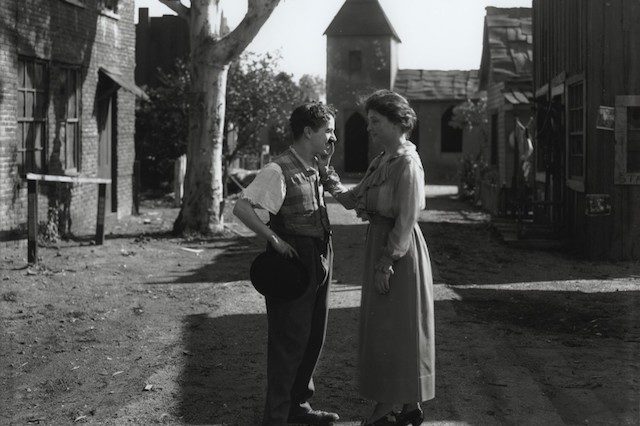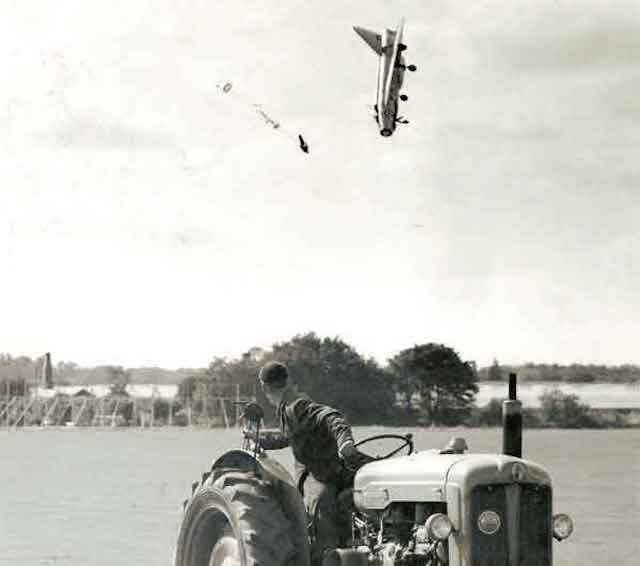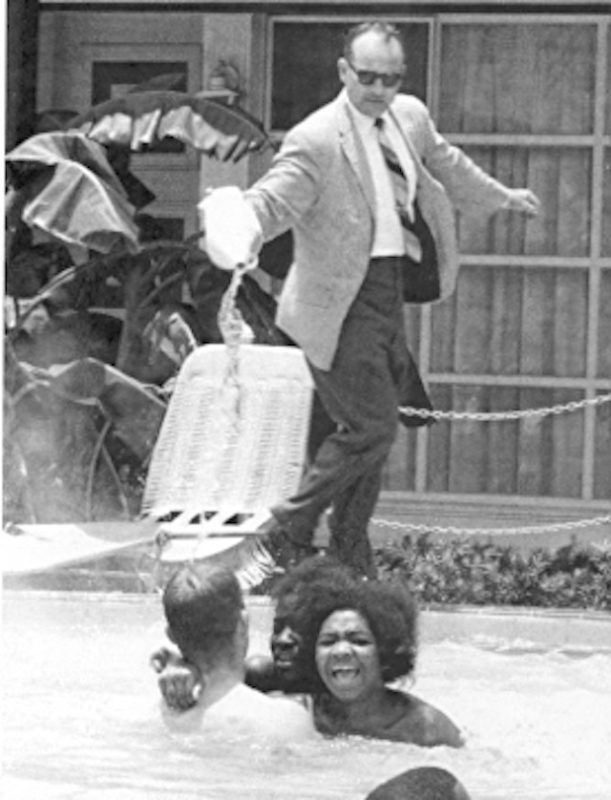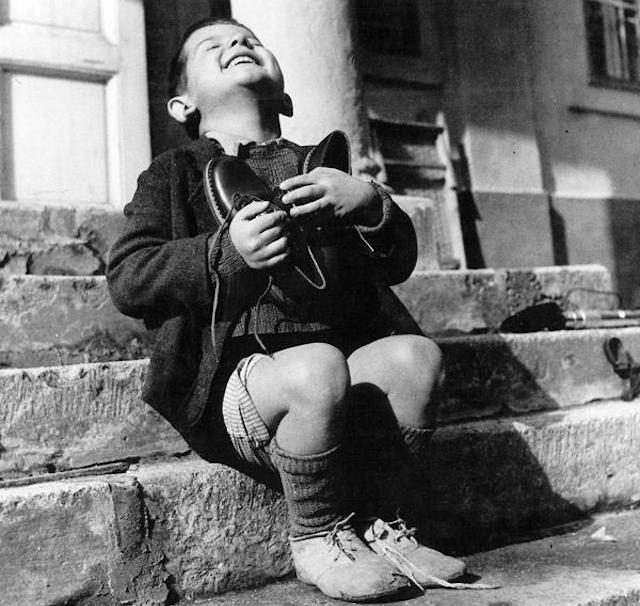These amazing pictures encapsulate some of the best and the worst aspects of humankind. All of them were taken in the days before cameras were everywhere and many times the photographer was lucky to be in the right place, at the right time, while holding a camera. And due to their amazing luck we have some breathtaking documentations of the past. These are the stories behind 10 of those amazing pictures.
10. Ham the Space Chimp

When the space program got started, scientists weren’t sure what would happen to the human body when it left Earth’s atmosphere. To research what might happen, both the United States and Russia, who were the two leaders in the space race, launched several animals into space. The Russians usually used dogs, while the United States used monkeys.
The first monkey to fly into space and return to Earth safely was Ham, who was named after the Holloman Aerospace Medical (HAM) Center. He is pictured here in this well timed photo, taken after his trip to space on January 31, 1961. In space, he had to perform a series of tasks, like pulling levers, and he knew to do that because of flashing lights. In total, the flight lasted 15 minutes and Ham was weightless for about six and a half minutes.
After his mission, Ham went to live in two different zoos and died in January 1983.
9. Helen Keller Meets Charlie Chaplin

Helen Keller was born on June 27, 1880, in Tuscumbia, Alabama. When she was just two years old, she fell ill, and as a result lost her vision and hearing. Starting in 1887, Keller started working with a teacher named Anne Sullivan, who eventually taught Keller to communicate.
In 1919, Keller met Charlie Chaplin, who was a big movie star at the time, resulting in this picture. She visited him at his studio when he was shooting the film Sunnyside. Keller put her hands on Chaplin’s lips and felt the vibrations in his throat to “listen” to him talk. She said that Chaplin was “Shy, almost timid, and his lovely modesty lent a touch of romance to an occasion that might otherwise have seemed quite ordinary.”
After the meeting, Keller and Sullivan joined Chaplin for a dinner party, which was followed by the screening of two of Chaplin’s movies, A Dog’s Life and Shoulder Arms. Before the screening, Chaplin wore the costumes that he wore in the films and he let Keller touch them, so she could get a sense of what he was wearing on screen. Then, using sign language on Keller’s palm, Sullivan described the scenes in the movies. Keller laughed and apparently didn’t miss any of the subtle humor.
8. The Great Paris Flood of 1910

The summer and autumn of 1909 were rainy ones in Paris, France, leading to extensive flooding in the city, making Paris look more like Venice in some areas. Boats were used to transport people down the streets, and other times, makeshift bridges were constructed so people could traverse the city.
Unfortunately, the streets of Paris were flooded for two months before the Seine returned to normal levels. 14,000 buildings were damaged, including a library, which caused the books to spill out onto the street.
In total, the flood caused 400 million francs worth of damage, which is the equivalent of over a billion dollars in 2017.
7. The First Space Selfie

On November 11, 1966, Jim Lovell and rookie pilot Edwin “Buzz” Aldrin launched from Cape Canaveral in the final flight of the Gemini Project – Gemini 12. On the mission, Aldrin snapped the first two human selfies in space. We say human, because you never know… there might be another species out in the universe who takes selfies as well. One selfie was Aldrin with the visor lowered and another one was of Aldrin with his visor rolled up. In the background of both selfies, it shows the blue curve of the Earth.
In total, the men spent just over five hours in space before returning safely to Earth. Three years later, Aldrin would become the second man to walk on the moon on July 20, 1969. Lovell would fly to the moon twice, but he never landed there. He is best known today as the commander of the Apollo 13 mission.
6. Princess Diana Meets With AIDS Patient

HIV and AIDS can be traced all the way back to the 1930s in what is today the Democratic Republic of Congo. In the 1970s, the disease unknowingly spread around the world. In 1981, medical officials in the United States noticed a spike in young gay men who developed a rare type of skin cancer and pneumonia. By the end of the year, 121 people had died from the mysterious disease.
When the disease, which was later called AIDS, first started killing people the victims were mostly gay men and drug addicts who shared needles. So for a long time HIV and AIDS didn’t attract much attention from the government and the media. A major turning point was when movie and TV star Rock Hudson appeared on TV looking gaunt and sick on July 25, 1985. During his appearance, Hudson, who was a gay man (but kept that part of his life secret) announced that he had AIDS. He died months later on October 2.
By the late 1980s, people were panicking about the disease and this led to people acting in fear, instead of compassion. One notable example is the plight of three young brothers, Ricky, Robert, and Randy Ray, who contracted HIV after being treated for hemophilia. The brothers, who were all under the age of 10, were banned from their elementary school in Arcadia, Florida. The family fought the banning and won. After winning their case, the family’s house was burned down and they moved out of town. The two eldest brothers, Ricky and Robert, both died due to AIDS complications years later.
A big problem with the disease was a lack of education. People weren’t sure if doing something like touching a person with HIV and AIDS was a way to contract it. Another problem was that even if someone knew they weren’t going to get AIDS from a handshake or a hug, they were worried about hurting the person who had the disease.
Someone who changed a lot of perceptions on HIV and AIDS was Diana, Princess of Wales. In the early 1990s, Princess Diana got heavily involved in AIDS awareness. She was often photographed shaking the hands of AIDS patients without a glove. One of the earliest photos of her visiting with an AIDS patient is the picture above. It was taken in October 1991, while Princess Diana was visiting the Casey House hospice in Toronto. The hospice was set up because, despite dying in a horrific way, AIDS victims were given harsh treatment in hospitals.
Princess Diana’s visit was a secret and when she visited the hospice, she spoke to the patients and gave them hugs, kissed them on the cheek, and shook their hands.
When asked about people who were nervous around people with AIDS and HIV, Princess Diana said, “HIV does not make people dangerous to know. You can shake their hands and give them a hug. Heaven knows they need it.”
5. George Aird’s Crash

Jim Mead was a professional photographer who lived near an airfield in Farnborough, England. On September 19, 1960, his next door neighbor, Bob Sowray, told him that he was going to be test flying a pre-production English Electric Lightning model XG332. So Mead decided to take a picture of his kids near the airfield as the Lightning landed.
However, as he walked towards the airfield, he noticed that a Lightning, which was actually being flown by George Aird and not his neighbor Sorway, was in some serious trouble. About 100 feet from the ground, the plane pitched up and Aird knew that he was in trouble. Aird ejected himself and crashed into a nearby greenhouse. He broke both legs and lost consciousness. Supposedly, the sprinkler system from the greenhouse woke him up and he thought that he was in heaven.
After snapping the once-in-a-life time picture, Mead tried to sell it to The Daily Mail, and they turned it down because they thought it was fake. So perhaps the real amazing part of this story is that The Daily Mail once had standards that high.
4. The Monson Motor Lodge Inn Incident

On June 18, 1964, Dr. Martin Luther King was in St. Augustine, Florida, and he tried to get into a “whites only” restaurant at the Monson Motor Lodge. Dr. King was denied entry and arrested. As part of the planned protest, white protesters who had rented motel rooms had black protesters join them as their guests in the pool, which was “whites only.”
Wanting them out of the pool, the motel owner, Jimmy Brock, poured a bottle of muriatic acid into the pool. Luckily, the acid was fairly weak and didn’t hurt anyone. Afterwards, the police jumped into the pool and arrested the swimmers. After the protesters were in jail, the jailers supposedly didn’t feed them because they weren’t properly dressed.
Even though the acid was weak, it’s not something one could surmise by looking at the picture that was taken by photographer Horace Cort. The pictures made headlines nationally and internationally. It embarrassed the United States and the day after the picture was taken, the Civil Rights Act of 1964 was passed after an 83 day filibuster.
3. The Bombing of Nagasaki

Originally, the second (and last) nuclear bomb to be used in warfare, the Fat Man, was supposed to be dropped on Japan on August 11, 1945. However, due to bad weather, the mission was bumped up by two days. At 3:47 am on August 9, a B-29 Superfortress named Bockscar took off from an American airbase located on the island of Tinian, which is in the North Pacific Ocean.
The primary target of the bomb was the city of Kokura, which had a population of about 178,000. However, when Bockscar flew over Kokura, it was covered in haze and smoke. So they decided to move on to another target. For reasons that aren’t clear, even to people involved with the bombing, they moved on to Nagasaki. Nagasaki wasn’t a target of the original nuclear bombing strategy. The Americans wanted to use the nuclear weapons on cities that weren’t damaged by other bombings. That way it would be a clear demonstration of what their nuclear weapons could do. However, Nagasaki had been bombed four times, as recently as a week before the nuclear bomb was dropped.
Nevertheless, the Bockscar flew to Nagasaki and dropped the Fat Man bomb. It detonated at 12:02 local time, 1,645 feet above the ground. While the Americans thought they were hitting an industrial area, it was a civilian district. According to the US government, 40,000 people were killed and 40,000 were injured.
This photo was taken by Hiromichi Matsuda about six miles away in the Koyagi-jima prefecture shortly after the bomb detonated. It was taken 15 minutes after the bomb went off and is believed to be the earliest ground photo of the explosion. In the picture, you can see three people reacting to the explosion.
2. New Shoes

World War II was tough for a lot of people in Europe, but it was especially rough for orphaned children. Thousands of children were left parentless because of the war and orphanages all around Europe were put under tremendous strain. This strain was still felt even a year after the war.
One of those war orphans who had to deal with more than his share of hardships was 6-year-old Hans Werfel, who lived at the Am Himmel orphanage in Vienna, Austria. In December 1946, Hans and the other children were given new clothes by the American Red Cross, and the picture is pretty self-explanatory about how he felt about his new shoes.
The picture was taken by Gerald Waller and appeared in Life magazine on December 30, 1946. In the caption that accompanied the picture, it said that many children had not seen new clothes since the start of the war and were overjoyed with their new clothes.
The picture appeared again in Life magazine five years later, after a woman wrote to the magazine and said that she kept the picture hung up to be more conscious of her petty complaints about life.
1. Muhammad Ali and the Suicidal Man

Muhammad Ali is considered one of, if not the greatest, athletes of all time. Unfortunately, his career didn’t end on a high note. Before his last fight, he failed a neurological test because he had Parkinson’s disease. Despite failing the test, the 38-year-old boxer was licensed to fight Larry Holmes on October 2, 1980. Holmes pummeled Ali and the fight was stopped in the 10th round by Ali’s team. After the bout, in an interview, Holmes cried and said, “All the people involved in this fight should’ve been arrested. This fight was an abomination, a crime.”
For the next three months, Ali stayed out of the limelight. Then something amazing happened on January 19, 1981. On that day, a despondent 21-year-old man climbed out onto the ledge on the 10th floor of a building in Los Angeles. Howard Bingham, Ali’s public relations manager, saw the man and asked the police if Ali, who lived a mile away, could help. The police turned him down, but Bingham went and called Ali anyway.
Ten minutes later, Ali got in his Rolls Royce and drove to the building. He even drove in the wrong lane, while flashing his lights. He talked to the police and they let him speak to the young man. The man, who wasn’t identified, couldn’t believe it was Ali speaking to him. Ali told the man that he loved him and cared about him. Ali also cried and said that he would help the young man if he stepped off the ledge.
After about 20 minutes of pleading with the suicidal man, he climbed in the window. Ali then led the man out of the building and into his car. He drove him to the police station, and afterwards he accompanied the man to the Veterans Administration Hospital.
Robert Grimminck is a Canadian freelance writer. You can friend him on Facebook, follow him on Twitter, follow him on Pinterest or visit his website, or his true crime YouTube channel.